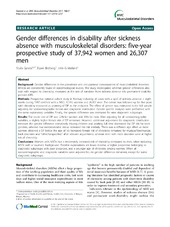Gender differences in disability after sickness absence with musculoskeletal disorders: five-year prospective study of 37,942 women and 26,307 men
Gender differences in disability after sickness absence with musculoskeletal disorders: five-year prospective study of 37,942 women and 26,307 men
| dc.contributor.author | Gjesdal, Sturla | en_US |
| dc.contributor.author | Bratberg, Espen | en_US |
| dc.contributor.author | Mæland, John Gunnar | en_US |
| dc.contributor.author | Gjesdal, Sturla | eng |
| dc.contributor.author | Bratberg, Espen | eng |
| dc.contributor.author | Mæland, John Gunnar | eng |
| dc.date.accessioned | 2011-04-01T09:27:31Z | |
| dc.date.available | 2011-04-01T09:27:31Z | |
| dc.date.issued | 2011-02-07 | eng |
| dc.identifier.issn | 1471-2474 | |
| dc.identifier.uri | https://hdl.handle.net/1956/4624 | |
| dc.description.abstract | Background Gender differences in the prevalence and occupational consequences of musculoskeletal disorders (MSDs) are consistently found in epidemiological studies. The study investigated whether gender differences also exist with respect to chronicity, measured as the rate of transition from sickness absence into permanent disability pension (DP). Methods Prospective national cohort study in Norway including all cases with a spell of sickness absence > eight weeks during 1997 certified with a MSD, 37,942 women and 26,307 men. The cohort was followed-up for five years with chronicity measured as granting of DP as the endpoint. The effect of gender was estimated in the full sample adjusting for sociodemographic factors and diagnostic distribution. Gender specific analyses were performed with the same explanatory variables. Finally, the gender difference was estimated for nine diagnostic subgroups. Results The crude rate of DP was 22% for women and 18% for men. After adjusting for all sociodemographic variables, a slightly higher female risk of DP remained. However, additional adjustment for diagnostic distribution removed the gender difference completely. Having children and working full time decreased the DP risk for both genders, whereas low socioeconomic status increased the risk similarly. There was a different age effect as more women obtained a DP below the age of 50. Increased female risk of chronicity remained for myalgia/fibromyalgia, back disorders and "other/unspecified" after relevant adjustments, whereas men with neck disorders were at higher risk of chronicity. Conclusions Women with MSDs had a moderately increased risk of chronicity compared to men, when including MSDs with a traumatic background. Possible explanations are lower income, a higher proportion belonging to diagnostic subgroups with poor prognosis, and a younger age of chronicity among women. When all sociodemographic and diagnostic variables were adjusted for, no gender difference remained, except for some diagnostic subgroups. | en_US |
| dc.publisher | BioMed Central | eng |
| dc.rights | Attribution CC BY | eng |
| dc.rights.uri | http://creativecommons.org/licenses/by/2.0 | eng |
| dc.title | Gender differences in disability after sickness absence with musculoskeletal disorders: five-year prospective study of 37,942 women and 26,307 men | en_US |
| dc.title | Gender differences in disability after sickness absence with musculoskeletal disorders: five-year prospective study of 37,942 women and 26,307 men | eng |
| dc.type | Peer reviewed | en_US |
| dc.type | Journal article | en_US |
| dc.description.version | publishedVersion | en_US |
| dc.description.version | publishedVersion | |
| dc.rights.holder | Gjesdal et al. | en_US |
| dc.rights.holder | Copyright 2011 Gjesdal et al; licensee BioMed Central Ltd. | en_US |
| dc.source.articlenumber | 37 | |
| dc.identifier.doi | https://doi.org/10.1186/1471-2474-12-37 | |
| dc.identifier.cristin | 830397 | |
| dc.source.journal | BMC Musculoskeletal Disorders | |
| dc.source.40 | 12 | |
| bibo.doi | eng |

